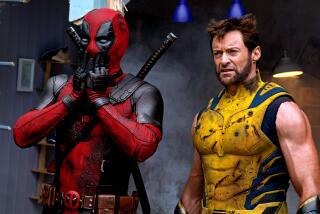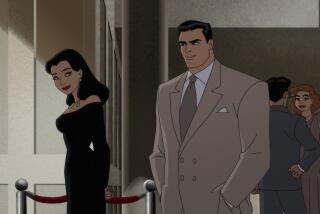A Blockbuster Deficit : ‘Batman’ Accounts Show a $35.8-Million Deficit for the Warners Hit That Grossed $253.4 Million; the Film May Never Show Profit
- Share via
Even as Warner Bros. Pictures is casting new villains for “Batman II,” the original blockbuster is still wallowing in red ink--thanks in large part to the Caped Crusader’s archenemy, the Joker.
The fifth-highest grossing motion picture in history and the No. 1 box-office hit of all time for Warners is still $35.8 million in the red and not likely to ever show a profit, according to financial statements obtained by The Times.
As of September, the dark comic-book tale starring Jack Nicholson as the Joker and Michael Keaton as Batman had grossed $253.4 million for Warners. But extraordinary outlays for advertising, publicity and high-priced talent such as Nicholson--as well as the studio’s normal hefty cut--have left the Batcoffers empty.
Under a Warners net-profit formula, the studio would have to take in at least an additional $150 million in gross receipts before the movie could begin turning a net profit, motion picture auditing experts have told The Times. Because the movie has already been shown in virtually every film market, from Abu Dhabi to Yugoslavia, and internationally exploited with saturation sales of videocassettes in Europe, South America and Asia, as well as the United States, experts say chances of “Batman” achieving an additional $150 million in receipts is virtually impossible.
Two income items have also come under scrutiny by net-profit participants. According to the studio, “Batman” merchandise featuring the ubiquitous “Batman” logo (T-shirts, toys, posters, etc.) only yielded $2.9 million, and records, which included the hit Prince single “Batdance,” grossed a paltry $382,213 for Warners.
Warners declined to comment Wednesday on the “Batman” financial statements. Rob Friedman, Warners president of worldwide advertising and publicity, said he was unfamiliar with the issue of net profits for “Batman” and needed to study the matter before commenting.
Warners has already started casting a sequel to the 1989 summer blockbuster. Keaton is expected to return in the title role with villains Danny DeVito as the Penguin and Oscar-nominee Annette Bening as the Catwoman.
“Batman” is the latest in a string of box-office hits whose huge grosses have turned out to be meaningless in terms of profits to the writers, producers and others who accepted net profit positions as part of their compensation for working on the film.
“Batman” joins a list that includes “Rain Man,” “Dick Tracy,” “Fatal Attraction” and “Coming to America” among the pantheon of hit movies whose bottom lines have been in red ink while gross receipts stood at more than $100 million.
According to movie accounting experts, “Batman’s” net-profit hopefuls are victims of the same infamous Hollywood demon: the rolling break-even point, or “rolling break,” as it is known in the industry. In the often baffling world of Hollywood accounting, expenses and interest can actually increase and compound with every additional dollar earned, rolling the point at which a movie breaks even ever higher.
“A rolling break means that the break-even point--that point at which a movie has gone from a loss to a profit--changes after the release of a film, depending upon the payments made to the star talent involved,” said Alex Ben Block, executive editor for special sections of The Hollywood Reporter trade paper. “A picture that has a big profit participation by a star actor, director or producer is never considered by studio accounting to ever break even.”
In the case of “Batman,” contracts were apparently negotiated with cast and producers granting such high percentages of the film’s total gross receipts to so many participants that the chances of the film ever showing a net profit are almost nil. The highest-grossing film of all time, “E.T.: the Extra-Terrestrial,” made $399.8 million domestically at the box office for Universal Pictures, according to Entertainment Data Inc.
According to financial statements for Benjamin Melniker and Michael Uslan, the two executive producers of “Batman,” the total gross receipts that had been taken in from domestic and foreign box office, TV, videocassette sales, records and merchandising stood at $253,381,234 before Warners began charging expenses to the film. The first chunk that came out was the studio’s distribution fee of about 35%, or $80 million, according to the producers’ profit participation statement for the period ending Sept. 30.
A “distribution fee” is a base percentage--usually in the 30% to 40% range--that all studios charge against a movie before meeting any of the film’s other expenses.
Then, the “Batman” pie began to be cut up, according to the statements obtained by The Times. Expenses included:
* $9 million for prints of the film;
* $1.1 million for editing, dubbing, subtitles and preprinting;
* $62.4 million for advertising and publicity;
* $4.7 million for taxes, duties, customs and fees;
* $2.1 million for trade associations;
* $1.4 million for freight, cartage, handling and insurance;
* $1.6 million for checking, collection and miscellaneous costs;
* $1.6 million for guild, union and residual payments.
Even with those expenses, the two-hour struggle between Batman and the Joker to dominate Gotham City showed net receipts of $87 million.
But, lurking like the Joker himself at the bottom of the Melniker-Uslan profit-participation statement was one more line item titled “investment and other deductions.”
By far the single largest charge to “Batman” is its actual production cost and the advances that the studio granted to the movie’s gross-profit participants, who reportedly include Nicholson, Keaton, director Tim Burton and the film’s producers, Jon Peters and Peter Guber. According to the Melniker-Uslan statement, the total for this “Batman” line item came to $112 million.
A second profit statement, issued to the late Warren Skaaren who co-wrote “Batman,” breaks down the production cost for the movie to $53,548,950--nearly $10 million less than Warners spent on advertising and publicity, according to the Melniker-Uslan statement. The studio has also maintained a practice of charging interest on the entire production cost as well, pushing the rolling break-even point even higher. As of Sept. 30, the studio had charged $10.8 million in interest.
Despite the interest charges and the high cost of production, “Batman” still might have shown a net profit if the deal makers who finally negotiated the contracts that put the film into production had not given such high gross-profit deals to “Batman’s” principals--particularly Nicholson.
In addition to a reported “up front” fee advance of $6 million, the actor reportedly negotiated one of the richest deals in Hollywood history: 15% of the gross with an escalator clause that boosted his take to as high as 20% the more money the film took in. Nicholson’s earnings alone account for more than $50 million of “Batman’s” production costs, according to industry sources.
Keaton, Guber, Peters and Burton reportedly had similar advances-against-gross built into the production cost of the film, but at a much smaller “adjusted gross” level than Nicholson.
In all, the gross-profit participants took about $60 million out of the “Batman” pie.
The bottom line for net profit participants, including the two executive producers Melniker and Uslan, who originally conceived the project, and screenwriters Sam Hamm and heirs of the late Warren Skaaren, who died of bone cancer Dec. 28, is that “Batman” remains $35,791,576 in the red. Their share of the net profits comes to exactly zero.
A LOOK AT THE BOOKS
“Batman’s” Bottom Line, September, 1990
Gross Receipts: $253.4 million
Distribution Fee: $80.4 million
Advertising and Publicity: $62.4 million
* Negative and Advance: $112.0 million
Interest: $10.9 million
Other: $23.5 million Deficit ($35.8 million)
* Actual production costs and payments to major stars and other “gross profit participants.”
SOURCE: Warner Bros.
More to Read
The biggest entertainment stories
Get our big stories about Hollywood, film, television, music, arts, culture and more right in your inbox as soon as they publish.
You may occasionally receive promotional content from the Los Angeles Times.










